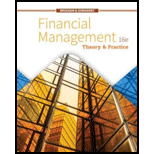
FINANCIAL MANAGEMENT
16th Edition
ISBN: 9781337902601
Author: Brigham
Publisher: CENGAGE L
expand_more
expand_more
format_list_bulleted
Question
Chapter 14, Problem 5P
Summary Introduction
To determine: Company’s new stock price by considering the stock split.
Expert Solution & Answer
Trending nowThis is a popular solution!

Students have asked these similar questions
Please don't sopve i mistakely posted blurr image.
i will give unhelpful if answer is incorrect..
I
no solve with assumption data Please don't solve i mistakely posted blurr image.
i will give unhelpful if answer is incorrect..
Chapter 14 Solutions
FINANCIAL MANAGEMENT
Ch. 14 - How would each of the following changes tend to...Ch. 14 - What is the difference between a stock dividend...Ch. 14 - One position expressed in the financial literature...Ch. 14 - Indicate whether the following statements are true...Ch. 14 - Puckett Products is planning for $5 million in...Ch. 14 - Petersen Company has a capital budget of 1.2...Ch. 14 - The Wei Corporation expects next year’s net income...Ch. 14 - A firm has 10 million shares outstanding with a...Ch. 14 - Prob. 5PCh. 14 - Gardial GreenLights, a manufacturer of...
Ch. 14 - Suppose you own 2,000 common shares of Laurence...Ch. 14 - Fauver Enterprises declared a 3-for-1 stock split...Ch. 14 - Harris Company must set its investment and...Ch. 14 - Boehm Corporation has had stable earnings growth...Ch. 14 - Prob. 11PCh. 14 - Bayani Bakerys most recent FCF was 48 million; the...Ch. 14 - Integrated Waveguide Technologies (IWT) is a...Ch. 14 - Discuss the effects on distribution policy...Ch. 14 - c. (1) Assume that IWT has completed its IPO and...Ch. 14 - (1) Describe the procedures a company follows when...Ch. 14 - Discuss the advantages and disadvantages of a firm...Ch. 14 - Suppose IWT has decided to distribute 50 million,...Ch. 14 - Describe the series of steps that most firms take...Ch. 14 - What are stock splits and stock dividends? What...Ch. 14 - What is a dividend reinvestment plan (DRIP), and...
Knowledge Booster
Similar questions
- Crenshaw, Incorporated, is considering the purchase of a $367,000 computer with an economic life of five years. The computer will be fully depreciated over five years using the straight-line method. The market value of the computer will be $67,000 in five years. The computer will replace five office employees whose combined annual salaries are $112,000. The machine will also immediately lower the firm's required net working capital by $87,000. This amount of net working capital will need to be replaced once the machine is sold. The corporate tax rate is 22 percent. The appropriate discount rate is 15 percent. Calculate the NPV of this project. Note: Do not round intermediate calculations and round your answer to 2 decimal places, e.g., 32.16. NPV Answer is complete but not entirely correct. S 103,141.80arrow_forwardYour firm is contemplating the purchase of a new $610,000 computer-based order entry system. The system will be depreciated straight-line to zero over its five-year life. It will be worth $66,000 at the end of that time. You will save $240,000 before taxes per year in order processing costs, and you will be able to reduce working capital by $81,000 (this is a one-time reduction). If the tax rate is 21 percent, what is the IRR for this project? Note: Do not round intermediate calculations and enter your answer as a percent rounded to 2 decimal places, e.g., 32.16. IRR %arrow_forwardQUESTION 1 Examine the information provided below and answer the following question. (10 MARKS) The hockey stick model of start-up financing, illustrated by the diagram below, has received a lot of attention in the entrepreneurial finance literature (Cumming & Johan, 2013; Kaplan & Strömberg, 2014; Gompers & Lerner, 2020). The model is often used to describe the typical funding and growth trajectory of many startups. The model emphasizes three main stages, each of which reflects a different phase of growth, risk, and funding expectations. Entrepreneur, 3 F's Debt(banks & microfinance) Research Business angels/Angel Venture funds/Venture capitalists Merger, Acquisition Grants investors PO Public market Growth (revenue) Break even point Pide 1st round Expansion 2nd round 3rd round Research commercial idea Pre-seed Initial concept Seed Early Expansion Financial stage Late IPO Inception and prototype Figure 1. The hockey stick model of start-up financing (Lasrado & Lugmayr, 2013) REQUIRED:…arrow_forward
- critically discuss the hockey stick model of a start-up financing. In your response, explain the model and discibe its three main stages, highlighting the key characteristics of each stage in terms of growth, risk, and funding expectations.arrow_forwardSolve this problem please .arrow_forwardSolve this finance question.arrow_forward
arrow_back_ios
SEE MORE QUESTIONS
arrow_forward_ios
Recommended textbooks for you
 Intermediate Financial Management (MindTap Course...FinanceISBN:9781337395083Author:Eugene F. Brigham, Phillip R. DavesPublisher:Cengage Learning
Intermediate Financial Management (MindTap Course...FinanceISBN:9781337395083Author:Eugene F. Brigham, Phillip R. DavesPublisher:Cengage Learning

Intermediate Financial Management (MindTap Course...
Finance
ISBN:9781337395083
Author:Eugene F. Brigham, Phillip R. Daves
Publisher:Cengage Learning
